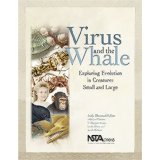From Viruses to Whales, Help Your Students Learn the Common Patterns of Evolution
By Carole Hayward
Posted on 2014-06-16
 What’s it like to study evolution as a scientist? That’s the question Judy Diamond, with the help of Carl Zimmer, E. Margaret Evans, Linda Allison, and Sarah Disbrow, set out to answer in writing Virus and the Whale: Exploring Evolution in Creatures Small and Large. The book issues an invitation to middle school students to get engaged in hands-on, inquiry-based activities that are based on current research projects—ones that have had a major influence on how today’s scientists think about evolution.
What’s it like to study evolution as a scientist? That’s the question Judy Diamond, with the help of Carl Zimmer, E. Margaret Evans, Linda Allison, and Sarah Disbrow, set out to answer in writing Virus and the Whale: Exploring Evolution in Creatures Small and Large. The book issues an invitation to middle school students to get engaged in hands-on, inquiry-based activities that are based on current research projects—ones that have had a major influence on how today’s scientists think about evolution.
The book is a product of the Explore Evolution project, a joint effort between science museums and 4-H organizations in the Midwest, to bring current research on evolution to middle schoolers and educators as well as the general public. Because the project has produced new permanent exhibit galleries for partner museums who are part of this effort (a full list of which can be found in the book) Virus and the Whale can be used in conjunction with these museum exhibits or as an independent resource.
The unique title of the book was taken from the central theme of the Explore Evolution project: “to show common patterns and principles in the evolution of organisms ranging in size from viruses to whales.” A secondary theme for the book is intended to show how scientific research uncovers new ideas “about how the natural world operates, and how these ideas are continuously modified by new research.”
“As educators, our task is to help young people feel that it means to view the world form a scientific and evolutionary perspective,” Diamond writes in the book’s preface. “This book provides durable, hands-on and easy-to-use activities to bring investigations about evolution to youth in any of the settings where they can do science with their peers.”
Eugenie C. Scott, executive director of the National Science Education Center, Inc., who wrote the introduction to the book, said, “students should know about (evolution) for the sheer intellectual joy of the experience.” Scott’s hope for the educators who read this (be they teachers, youth leaders, or museum curators) is that they can help people “appreciate evolution and how it helps us to makes sense of so much of the living world.”
Designed to encourage social interaction between young people, the book’s activities will work in practically any setting. Each activity begins with a short essay that gives students an overview of a scientist’s research project on a particular organism and is followed up by a four-part, hands-on activity. Students first go through a brief exercise, which introduces them to the organism being studied. This is followed by two sections of investigations, each based on an aspect of the scientist’s research. The two final sections of each activity include an assessment tool where students are asked to think like a science reporter and then summarize their understanding of the chapter’s activities.
Whether it’s a middle school science classroom, a club or an afterschool program, this book’s easy-to-use activities provide the perfect launch pad for making the teaching of evolution interesting and relatable. There’s even some humor thrown in for good measure—something every middle school educator can appreciate!
This book is also available as an e-book.
Disclaimer: The views expressed in this blog post are those of the author(s) and do not necessarily reflect the official position of the National Science Teaching Association (NSTA).


